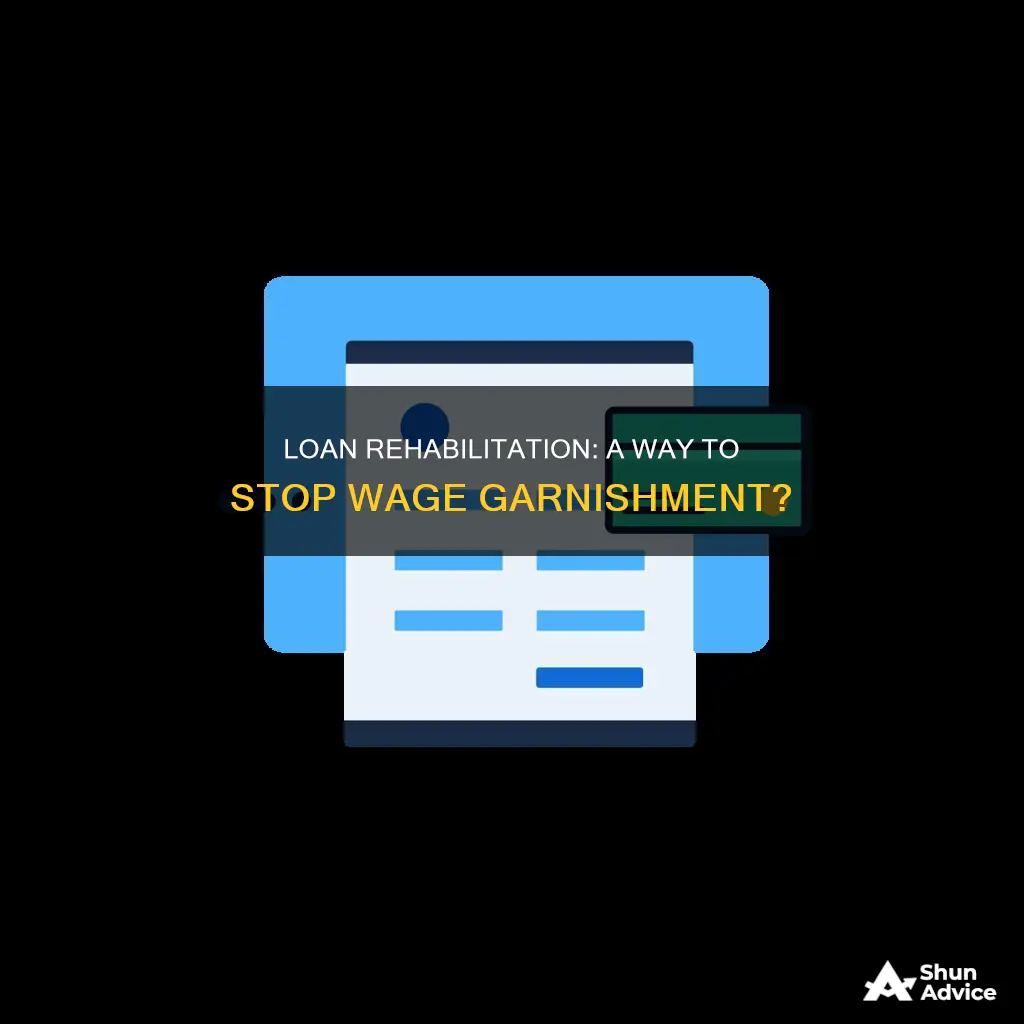
Wage garnishment is a legal procedure where a creditor can require an employer to withhold a portion of an employee's paycheck to pay off debts. It can be a stressful situation for many, and there are ways to prevent and stop it. One way to stop wage garnishment is loan rehabilitation, which is available for federal student loans. This involves making nine monthly payments over ten consecutive months, removing the loan's default status from credit reports. However, it is a one-time option, so agreeing to it should be done with certainty that the terms can be met.
Does loan rehabilitation stop wage garnishment?
| Characteristics | Values |
|---|---|
| Definition of wage garnishment | A legal procedure through which a portion of a person's earnings is withheld for debt repayment |
| Reasons for wage garnishment | Child support, consumer debts, student loans, unpaid taxes, non-tax debts owed to the federal government |
| Preventing wage garnishment | Making consistent, timely payments, setting up automatic payments or reminders |
| Stopping wage garnishment | Paying off the debt, filing an objection with the court, filing for bankruptcy, contacting creditors to negotiate, loan rehabilitation |
| Loan rehabilitation | A one-time option to stop wage garnishment and remove the loan's default status from a credit report; requires making 9 monthly payments in 10 months |
| Limits on wage garnishment | The Consumer Credit Protection Act (CCPA) limits the amount that can be garnished and protects employees from being fired for garnishment for a single debt |
What You'll Learn

Loan rehabilitation removes default status from credit reports
Wage garnishment is when a portion of your income or bank balance is legally withheld to settle a debt. It is a tool that debt collectors can use if you can't pay back a debt. It is important to note that wage garnishment is different from voluntary wage assignments, where employees voluntarily agree that their employers may turn over a specified amount of their earnings to a creditor or creditors.
If you have defaulted on your student debt, loan rehabilitation can be a life-saver. It stops wage garnishment and also removes your loan's default status from your credit report. However, loan rehabilitation is typically only available for federal student loans and is a one-time opportunity, so it is important to be sure that you can meet the terms before agreeing to it. To enrol in a loan rehabilitation program, you must contact your loan holder to see if you are eligible. If you are, they will request your latest tax returns and calculate a monthly payment equal to 15% of your discretionary income. You must then agree to make nine monthly payments during a period of ten consecutive months to be enrolled in the loan rehabilitation program.
For private student loans, there may not be many rehabilitation options available. However, you can still contact your lender or debt collector to see if you can negotiate a repayment plan or a lower debt payoff amount. If your wages are already being garnished, you may be able to stop it by paying the debt in full, filing an objection with the court, or filing for bankruptcy. If you have other ways to come up with the money, such as borrowing from family or friends, you can eliminate the debt and resolve the need for garnishment.
It is important to note that a garnishment judgment will stay on your credit reports for up to seven years and may affect your credit score. Therefore, it is crucial to consider ways to rebuild your credit after dealing with your most pressing debt issues. Additionally, there are legal rights and protections in place regarding wage garnishment, including caps on the maximum amount that can be garnished at once and protection from termination if wages are garnished for a single debt. These protections are provided by the Consumer Credit Protection Act (CCPA) and apply in all 50 states, the District of Columbia, and all US territories and possessions.
Loan Regulations: State-by-State Differences in the USA
You may want to see also

Wage garnishment is when a portion of income is withheld to settle debt
Wage garnishment is a legal procedure that allows creditors to take money from your paycheck or bank account to settle a debt. This usually occurs when a creditor sues you for non-payment and wins in court. However, in some cases, such as unpaid taxes or federal student loans, creditors can force garnishment without a court order.
The Consumer Credit Protection Act (CCPA) limits the amount of an individual's earnings that can be garnished and protects employees from being fired due to wage garnishment for a single debt. The CCPA applies in all 50 states and US territories. For ordinary garnishments, the weekly amount is limited to the lesser of two figures: 25% of the employee's disposable earnings or the amount by which their disposable earnings exceed 30 times the federal minimum wage ($7.25 per hour). If disposable earnings are $217.50 or less, there can be no garnishment. However, if disposable earnings are between $217.50 and $290, only the amount above $217.50 can be garnished. If disposable earnings are $290 or higher, a maximum of 25% can be garnished.
Different garnishment rules apply to different types of debt. For example, child support or alimony can be garnished up to 60% (or 50% if supporting another spouse or child) of disposable wages, with an additional 5% if payments are more than 12 weeks late. Federal student loans can be garnished up to 15% of disposable earnings. Exempted income for back taxes is based on filing status and the number of dependents.
To stop wage garnishment, you can pay off the debt, challenge the garnishment, or file for bankruptcy. Contacting creditors to negotiate a payment plan or objecting to the garnishment in court are also options. If the garnishment was made in error, causes undue harm, or is improperly executed, you have the right to contest it. Additionally, loan rehabilitation, consolidation, or settlement are possible avenues to explore, especially for federal student loans.

Creditors can legally require employers to hand over part of earnings
Wage garnishment is when a portion of your income or bank balance is legally withheld to settle a debt. It is a court order issued by a judge that instructs an employer to withhold a portion of an employee's paycheck and send it directly to the creditor or person to whom the employee owes money. The court will send notices to the debtor, their employer, and their bank.
Creditors can legally require employers to hand over part of a debtor's earnings. This is called a wage garnishment. It is a court-ordered requirement that allows creditors to seize funds directly from the debtor's wages or bank account. To do so, a creditor must present their case in front of a judge and obtain a legal judgment against the borrower. If they are successful, the court will send an earnings withholding order to the debtor's employer, informing them of their legal obligation to deduct a specified sum from the debtor's paycheck and forward it to a third party known as the levying officer. The debtor's employer is then required to act on the court's behalf by deducting the funds from the debtor's paycheck and forwarding them to the levying officer.
The maximum amount that a creditor can garnish from a debtor's wages depends on how much they earn and the type of debt. For example, for back child support or alimony, up to 60% of disposable wages can be garnished, while for federal student loans, the limit is 15%. It is important to note that wage garnishment laws vary depending on the jurisdiction, and there are regulations on how much of a debtor's income can be diverted to debt repayment.
If you are facing wage garnishment, there are several options to handle it:
- Contact your creditors to negotiate a payment plan.
- Object to the garnishment in court if you believe it was made in error, will cause undue harm, or is being improperly executed.
- Pay off the debt in full or in installments as stated in the judgment.
- Consider consolidating the debt with another loan to give yourself more time to make a long-term plan for repayment.

Wage garnishment is possible in all 50 states
Wage garnishment is when a court orders your employer to withhold a portion of your paycheck and send it directly to the creditor or person to whom you owe money. It is a means of collecting monetary judgments. Wage garnishment is possible in all 50 states, and it can occur in several ways. Firstly, a creditor can legally require your employer to hand over part of your earnings to pay off your debts. This typically happens when a creditor sues you for non-payment and wins in court. However, in some cases, a creditor can force garnishment without a court order, such as when you owe back taxes or a balance on federal student loans.
It is important to note that while wage garnishment is possible in all states, there are varying laws and thresholds for the amount that can be garnished. These laws differ depending on the type of debt, with separate rules for tax debt, child support, federal student loans, and court-ordered fines. In general, for ordinary garnishments, the weekly amount cannot exceed 25% of the employee's disposable earnings or the amount by which disposable earnings exceed 30 times the federal minimum wage. For example, if your disposable earnings are $290 or more per week, a maximum of 25% can be garnished. Additionally, there are specific thresholds for different types of debt. For instance, up to 60% of disposable wages can be garnished for back child support or alimony, and up to 15% for federal student loans.
If you are facing wage garnishment, you have several options to handle the situation. Firstly, you can contact your creditors to negotiate a payment plan that fits your budget. Secondly, if you believe the garnishment was made in error or will cause undue harm, you can object in court, although you must act quickly, usually within five business days. Additionally, you can pay off the garnishment in installments or as a lump sum, either by borrowing money or using your savings. It is important to note that a garnishment judgment will remain on your credit report for up to seven years and may impact your credit score.
Loan rehabilitation is one of the options available to borrowers of federal loans to get out of default. While it can help prevent wage garnishment from occurring in the first place, it may not stop it once it has already started. If you are facing wage garnishment due to federal student loans, requesting a hearing within 30 days of being notified can prevent the government from taking money from your paycheck. At the hearing, you can present your case and ensure that the proper paperwork is in order. However, if the garnishment has already begun, there is a chance it might continue even after the hearing, but it can still be stopped.

There are ways to prevent and stop wage garnishment
Wage garnishment is when a court orders that your employer withhold a portion of your paycheck and send it directly to the creditor or person to whom you owe money. This can be a heavy burden, especially when you are already struggling to keep up with your financial obligations. However, there are ways to prevent and stop wage garnishment.
Preventing Wage Garnishment
If you are in default on your federal student loans or are trying to stop it before it happens, you may want to get professional help. Negotiating with your lender or collector about a new repayment plan or a settlement is an option if you are in default. Getting out of default is the best option, but if you can't, you have protections and rights available to you if you face wage garnishment.
Stopping Wage Garnishment
If your wages or bank account have been garnished, you may be able to stop it by paying the debt in full, filing an objection with the court, or filing for bankruptcy. If you've stopped paying a debt, your creditor could sue you and try to get a judgment from a court. Once this happens, the creditor could request that the court garnish your wages or your bank account to pay back the debt. If you believe the garnishment was made in error, will cause undue harm, or is being improperly executed, you can object in court. You’ll have to act quickly, as you may have only five business days or 14 days to contest the ruling.
If your financial situation is dire, paying off the debt may not be an option. But if you have other ways to come up with the money, eliminating the debt will resolve the need for a garnishment. For example, you could ask for help from family members or friends. Depending on your credit, you could also consider consolidating the debt with another loan. The latter option won't get rid of the debt, but it'll pay off the original debt and give you the breathing room to make a long-term plan for paying it off.
If you are facing or experiencing garnishment, don't despair – there are solutions. Filing for bankruptcy will stop any existing garnishment activities. Depending on the type of bankruptcy you qualify for, you may be able to get on a restructured payment plan that works with your financial situation.
Frequently asked questions
Wage garnishment is when a portion of your income or bank balance is legally withheld to settle a debt.
Yes, loan rehabilitation can stop wage garnishment. Loan rehabilitation is a program that removes your loan’s default status from your credit report. However, loan rehabilitation is a one-time lifeline, so it is important to be sure that you can meet the terms.
Some other ways to stop wage garnishment include paying off the debt, filing an objection with the court, filing for bankruptcy, consolidating your loans, or negotiating a payment plan.







